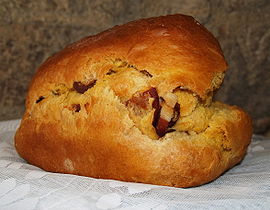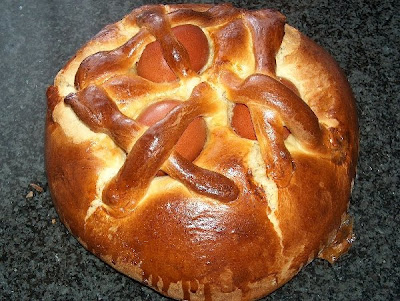Easter in Portugal is a very special occasion for godparents and their godchildren.
The tradition says the goddaughter or the godson should visit their godparents and ask for the Folar.
The Folar da Páscoa is a kind of bread or cake, salty or sweet, depending on the region of the country. If it is from the North (the most popular is the Folar de Chaves,) it is salty. If it is from the South (Algarve,) it is sweet.
The Folar da Páscoa is a symbol of brotherhood, friendship and reconciliation, and when covered with eggs, as in the South, it is also a symbol of fertility, rebirth and resurrection.
The obligation of giving a Folar to the godsons ends when they become adults (18 years old) or when they marry.
The godsons should offer too a present to their godmothers a week before on Palm Sunday: a violets bouquet and a bag of sweet almonds.
In the North of Portugal, according to the tradition, we should offer a Folar to the local priest when he goes to the village, visiting and blessing the parishioners’ houses . We call this visit and procession “Compasso” .
These are the photos and the recipes of these two kinds of Folar.
Enjoy!
Folar de Chaves (North of Portugal, Trás-os-Montes province)
Ingredients
500 grams of fermented bread dough
6 eggs
1 decilitre of olive oil
75 grams of lard
100 grams of unsalted ham
100 grams of fresh bacon
500 grams of boneless meat (smoked sausages, veal, pork, rabbit, goat or chicken tenderloins)
lard, salt, egg yolk and flour as needed.
Preparation:
Mix the dough with the eggs, the olive oil and the melted lard.
Season it with salt and batter everything with your hands until it’s well mixed.
Gradually add bits of flour until it’s consistent enough to stretch.
Fry the meats aside with lard.
Split the mixed dough in 4 or 5 parts, using the biggest piece to cover the bottom as well as the sides of a round and high mould, previously covered with lard.
Then add alternated layers of meat and dough, making sure that the last (top) layer is of dough.
Press the borders of the dough to stick to the container and brush the surface with whisked yolk.
Let it rest and rise for 2 hours and bake it in the oven (200 degrees).
Folar do Algarve (South of Portugal)
Ingredients
800 grams of wheat flour
100 grams of margarine
35 grams of baker’s yeast
250 grams of white sugar
3 eggs
2 decilitres of warm milk
salt, cinnamon and fennel as needed
3 or 4 eggs to decorate the folar
Preparation
Dissolve the yeast with a bit of warm milk and add a bit of flour. Mix it (with your hands) into a very moist ball and let it rise for 20 minutes.
Knead the rest of the flour with the sugar, the milk and the eggs, and add the yeast ball. Knead it very well. Add the margarine, the salt (just a pinch) and the spices.
Batter until the dough easily unsticks from the container. Let it ferment in a bowl, covered with a cloth in a safe environment with a mild temperature, for about 3 hours.
Take the dough, reserve a small part (guess how much after reading what it will be used for) and make a mildly squashed ball with the rest (the bigger part), where you should put the already boiled eggs (and cold).
With the reserved dough, make some strings which you place around the eggs, for decoration.
Brush the folar with whisked yolk and let it ferment for a bit. Bake it in a hot oven (200 degrees) until it’s well cooked and takes a brownish tone.







Que interessante! Na verdade, desconhecia quase tudo!!
O folar de Chaves é a “bola”? Tem um excelente aspecto.
Só conhecia aquele que chamas do Algarve (mas que nunca comi no Algarve e sim em Lisboa ou na zona de Coimbra) e não aprecio.
Quanto aos presentes dos padrinhos é que conhecia mais ou menos. Mas na minha família os padrinhos dão uma prenda aos afilhados e é tudo… Quando dão – porque as pessoas cada vez se vêem menos.
Enfim, as tradições perdem-se e é pena.
OH HOW I LOVE THIS BREAD,SANDRA! Have a magnificent day! Thank you for letting me know about your post! Anita
@Margarida:
The Folar de Chaves is the first one. The second one (called from Algarve ) is also eaten in Lisbon, Coimbra and other regions nearby. In Algarve, there is another one, from Olhao. The egg isn’t placed on the top of the cake, but in the middle. I like this one very much too.
However, my favourite is the one we eat in the North of Portugal.
@ Anita:
Now you know what you should try on Easter holidays in Portugal. And with a glass of Port wine, of course ;-))
Sandra,
Thanks a lot! I never ate the Folar de Chaves.
I love the symbol and the history of the Folar cakes.
Lovely post. 🙂
@Ana:
Thanks, Ana! I agree with you. A lovely simbology!
What a concidence, Sandra! This past weekend I went to Montalegre and ate the folar. Even if Easter is gone, it is always delicious. I also tried the “bica”, also salty and with little pieces of pork inside. Very good!